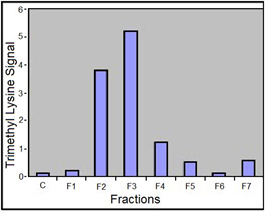联系我们
电 话:0771-2310996
传 真:0771-2310995
E-mail : 735565094@qq.com
技术支持E-mail: immunechem@gmail.com 备案号:桂ICP备09007987号
地 址:广西南宁市高新技术开发区科园大道68号东盟慧谷11栋203室 530007
Trimethyl Lysine Antibody, Agarose
|
Catalog # Product Description |
ICP0606 This trimethyl lysine antibody is immobilized to beaded agarose via amide linkages. The product could be utilized as an affinity matrix for rapid isolation and purification of proteins or peptides with trimethyl lysine residues. |
|

Elution profile of the trimethyl lysine signal from the affinity column (anti-trimethyl lysine agarose), sample loaded is from the trypsinated mouse spleen extract.
|
|
Formulation
|
0.5 mL beaded agarose suspended in 1 mL slurry
|
||
|
Antibody Immobilized
|
4 mg/mL of antibody is covalently linked through an amide bond with NHS activated-SMCC then linked to thiolated agarose beads via a thiol ether bond.
|
||
|
Binding Capacity
|
Approximately 0.2 mg of trimethylated histone per mL
|
||
|
Specificity
|
Captures the peptides and proteins with trimethylated lysine residues (n-epsilon); antibody does not cross react with acetylated proteins or mono- and dimethylated proteins.
|
||
|
Applications
|
IP; Immuno-Affinity Chromatography
|
||
|
Scientific Description
|
Protein lysine trimethylation is one of the important events in post-translational modification. Trimethylation of histones have been extensively studied. The non-histone trimethylation may also play an important role in protein functions. This simple and effective tool for rapid isolation and purification of the trimethylated species is essential for proteomic profiling of the trimethylated proteins in different stages of development, disease, and signal stimulation, and identification of the protein trimethylation site.
|
||
| Storage & Stability | Product is stable for several weeks at 4°C. For extended storage, aliquot content and store product at -20°C. Avoid cycles of freezing and thawing. Expiration date is one year from date of shipping if stored properly. | ||
|
Product Specific References
|
1. Mol. BioSyst. 2013. 9: 2231-2247. doi: 10.1039/C3MB00009E
2. Biochem & Biophys Res. Com. 2014. 451 (2): 229-234. doi: 10.1016/j.bbrc.2014.07.11
3. Proteomics. 2015. 15 (13): 2166–2176. doi: 10.1002/pmic.201400521 |